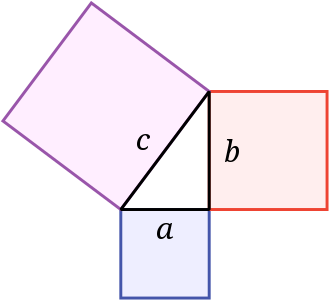Timeless Theorems of Mathematics/Pythagorean Theorem
The Pythagorean Theorem is a fundamental relation between the three sides of a right triangle in Euclidean Geometry. It states that the square of the hypotenuse side is equal to the sum of squares of the other two sides in a right-angled triangle.[1]

The theorem is named after the Greek philosopher Pythagoras (570 – 495 BC). But, both the Egyptians and the Babylonians were aware of versions of the Pythagorean theorem about 1500 years before Pythagoras.
Proof
Statement
In a right-angled triangle, the square on the hypotenuse is equal to the sum of the squares on the two other sides.
Proof with the help of two right angled triangles
Proposition : Let in the triangle °, the hypotenuse and . It is required to prove that i.e. .
Construction : Produce up to in such a way that . Also, draw perpendicular at on produced, so that . Join and .

Proof : In and , and included = included [As °]
Therefore, . [Side-Angle-Side theorem]
∴ and .
Again, since and . Therefore, is a trapezoid.
°
or, °°
or, °
or, ° [As ]
Again, °
or, °
or °
∴ is a right triangle.
Now, Trapezoid
or,
or,
or,
or,
or,
or, [Proved]
[Note : The 12th President of the United States of America, James A. Garfield proved the Pythagorean Theorem with the help of two right angled triangles. His proof of the Pythagorean Theorem was published on page 161 of the New-England Journal of Education, April 1, 1876][2]
Proof with the help of similar triangles
Proof with the help of Algebra
Proposition : Let, in the triangle is the hypotenuse and be the two other sides. It is required to prove that, .

Construction : Draw four triangles congruent to as shown in the figure.
Proof : The large shape in the figure is a square with an area of [As teh length of every side is same, and the angles are right angles]
The area of the small quadrilateral is , as the shape is a square. [As, every side is and every angle of the quadrilateral is right angle (proved while proving with the help of two right angled triangles)]
According to the figure,
Or,
Or, [Proved]